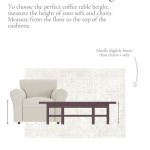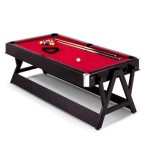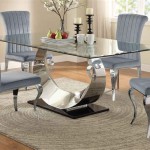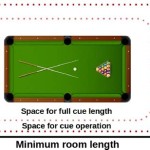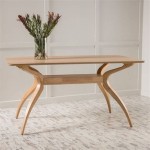What Height Should a Coffee Table Be? A Comprehensive Guide
Choosing the correct height for a coffee table is essential for creating a functional and aesthetically pleasing living space. A coffee table that is too tall or too short can disrupt the flow of a room, make it uncomfortable to use, and detract from its overall visual appeal. Determining the optimal height involves considering several factors, including the height of the sofa, the intended use of the table, and the overall style of the room.
The coffee table serves various purposes, from providing a surface for beverages and snacks to acting as a focal point in the room's design. Therefore, the height should facilitate these functions comfortably and harmoniously. This article provides a detailed exploration of the factors that influence the ideal coffee table height, offering practical guidance for homeowners and interior designers seeking to make informed decisions.
The Relationship Between Sofa Height and Coffee Table Height
The most critical factor in determining the correct coffee table height is the height of the sofa. A general rule of thumb suggests that the coffee table should be approximately the same height as the sofa cushions or slightly lower. This ensures easy access to items placed on the table without requiring users to reach awkwardly or strain themselves. Specifically, the ideal coffee table height typically falls within 1-2 inches of the sofa's seat height.
To accurately determine the necessary coffee table height, the sofa's seat height should be measured from the floor to the top of the cushions. Sofas generally range in height from 16 to 20 inches, making coffee tables in the 16-to-18-inch range a common choice. For sofas with higher seats, a taller coffee table may be more appropriate, while lower sofas necessitate a lower coffee table to maintain ergonomic comfort.
Deviation from this general guideline can be acceptable, but careful consideration must be given to the specific circumstances. For instance, if the sofa has particularly plush or oversized cushions, selecting a coffee table that is slightly lower than the cushion height might prove more practical. Conversely, if the sofa is minimalist with firm cushions, a coffee table closer to the sofa's seat height may be preferred. Ultimately, the goal is to create a comfortable and visually balanced arrangement.
The style of the sofa can also influence the perceived appropriateness of the coffee table height. A modern, low-slung sofa often pairs well with a lower coffee table, reinforcing the contemporary aesthetic. In contrast, a more traditional sofa with a higher profile might benefit from a slightly taller coffee table to maintain a sense of proportion and formality. The interplay between the sofa's style and the coffee table's height contributes significantly to the overall harmony of the room.
Considering Intended Use and Functionality
Beyond its relationship to the sofa's height, the intended use of the coffee table directly impacts the selection of an appropriate height. A coffee table primarily used for serving food and beverages should ideally sit at a height that facilitates comfortable dining or snacking while seated on the sofa. In such cases, a slightly taller coffee table, perhaps even reaching 18 to 20 inches, may be preferable.
If the coffee table serves as a workspace for activities such as reading, writing, or using a laptop, a height that allows for comfortable posture is crucial. A coffee table that is too low can induce slouching and strain the neck and back. In these scenarios, the height may need to be adjusted upwards to promote better ergonomics. However, it is important to avoid exceeding a height that would make conversing with others on the sofa awkward.
Furthermore, storage requirements can influence the height of the coffee table. Coffee tables with built-in drawers or shelves often have a higher profile than simpler designs. If storage is a primary concern, the additional height should be factored into the overall calculation to ensure it remains functional and aesthetically consistent with the rest of the furniture in the room.
The presence of children or pets in the household may also influence the decision-making process. A coffee table with sharp edges or protruding elements could pose a safety hazard. Opting for a coffee table with rounded edges and a stable base can mitigate these risks. The height should also be considered to ensure that young children cannot easily reach items placed on the table that may be unsafe.
The Impact of Room Size and Style
The overall dimensions of the room play a significant role in determining the most suitable coffee table height. In a smaller living space, a lower coffee table can help create a sense of spaciousness by minimizing visual obstruction. Conversely, in a larger room, a taller coffee table can anchor the seating area and prevent the space from feeling too scattered or empty.
The style of the room also influences the choice of coffee table height. In a formal living room, a taller coffee table may be appropriate to complement the more traditional and structured aesthetic. In contrast, a casual or bohemian-style living room might benefit from a lower, more relaxed coffee table that reinforces the informal ambiance. The coffee table should harmonize with the existing décor and contribute to the overall visual coherence of the space.
The presence of other design elements, such as area rugs and accent furniture, should also be considered. A coffee table that is too high can dwarf a small area rug, while a coffee table that is too low can get lost in a larger rug. The height should be proportional to the surrounding elements to create a balanced and visually appealing composition.
Moreover, the architectural features of the room, such as ceiling height and window placement, can influence the perceived scale of the furniture. In rooms with high ceilings, a slightly taller coffee table may be necessary to prevent the space from feeling disproportionate. In rooms with low ceilings, a lower coffee table can help maintain a sense of verticality and prevent the space from feeling cramped.
Ultimately, selecting the correct coffee table height requires a holistic approach that considers a multitude of factors. The relationship between the sofa height and the coffee table height forms the foundation of the decision-making process. However, it is equally important to consider the intended use of the table, the overall style of the room, and the presence of other design elements. By carefully evaluating these factors, it is possible to choose a coffee table height that enhances the functionality and aesthetic appeal of the living space.
In addition to the height, the shape and size of the coffee table should also be considered in relation to the sofa and the room. A rectangular coffee table is often a good choice for longer sofas, while a square or round coffee table may be more suitable for smaller seating areas or sectional sofas. The size of the coffee table should be proportional to the sofa and the available space to avoid overcrowding the room or leaving it feeling sparse. The materials and finish of the coffee table should also complement the other furniture and décor in the room. A wooden coffee table can add warmth and character to a space, while a glass or metal coffee table can create a more modern and contemporary look.
The placement of the coffee table is another important consideration. It should be positioned within easy reach of the sofa, typically about 14 to 18 inches away, to allow for comfortable access to drinks, snacks, and other items. However, it should not be placed so close that it obstructs movement around the room. In smaller spaces, a coffee table with wheels or casters can be a practical option, allowing it to be easily moved out of the way when not in use. This flexibility can be particularly useful for accommodating guests or creating extra space for activities.
Before making a final decision, it can be helpful to measure the height of the sofa and the available space to ensure that the coffee table will fit comfortably. Consider using painter's tape to mark out the dimensions of the coffee table on the floor to visualize its placement and size in the room. This can help prevent purchasing a coffee table that is too large or too small for the space. It is also advisable to try out different coffee table heights in a furniture store to get a feel for what is most comfortable and practical. This hands-on experience can provide valuable insights that are difficult to obtain from online research or measurements alone. Remember that the ideal coffee table height is not a fixed number but rather a range that depends on individual preferences and the specific characteristics of the room.

Coffee Table Dimension Guide Ashley Homestore

The Ultimate Coffee Table Size Guide Apt2b

How To Buy A Coffee Table Living Spaces

How To Choose The Right Size Coffee Table Happy Haute Home

How High Should A Coffee Table Be

Guide To Coffee Table Height Size Get The Right For Your Room Housist

Coffee Table Dimension Guide Ashley Homestore

Coffee Table Dimensions How To Choose The Right Size Tidbits Twine

How High Should A Coffee Table Be

How To Choose The Right Size Shape Coffee Table For Your Living Space

